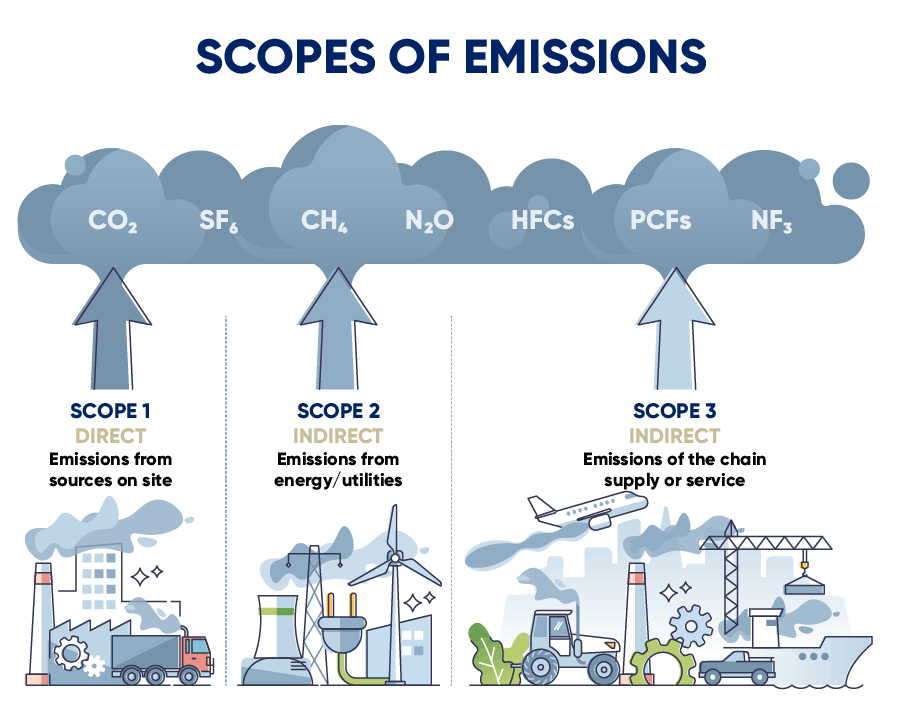The world is in a race against time to combat the devastating impacts of climate change, and businesses have a crucial role to play. By understanding and reducing Scope 1, 2, and 3 carbon emissions, organisations can significantly contribute to global sustainability efforts. In this blog post, we’ll explore the importance of these emissions, key concepts like greenhouse gases, carbon footprint, and net zero, as well as strategies and case studies to inspire successful carbon reduction efforts.
Table of Contents:
- The Importance of Sustainability and Carbon Emissions
- Climate Change and its Impact
- The Role of Businesses in Sustainability
- Key Concepts: Greenhouse Gases, Carbon Footprint, and Net Zero
- Understanding Scope 1, 2, and 3 Emissions
- Strategies for Reducing Carbon Emissions
- Reporting and Compliance
- Case Studies: Successful Carbon Reduction Efforts
- Summary
Key Takeaways
-
Organisations must commit to sustainability and reduce their carbon emissions in order to combat climate change, improve reputation, and save costs.
-
Understanding greenhouse gases, carbon footprints, net zero is essential for reducing emissions & contributing to a sustainable future.
-
Organisations can identify reduction opportunities by understanding Scope 1–3 emissions & implementing strategies such as energy efficiency measures & renewable energy sources.
The Importance of Sustainability and Carbon Emissions
Climate change has far-reaching effects on the environment, economy, and society, such as extreme weather events, increasing sea levels, and depletion of biodiversity. Waste generated by businesses can amplify the consequences of climate change. Therefore, organisations bear a significant responsibility to lessen their environmental impact by curbing their carbon emissions, which include Scope 1 and 2 emissions.
Businesses that commit to sustainable development can:
-
Contribute to addressing climate change
-
Improve their reputation
-
Comply with regulatory requirements
Grasping key concepts related to carbon emissions, including greenhouse gases, carbon footprint, and emission reduction strategies, equips organisations to methodically strive for a more sustainable future.
Climate Change and its Impact
Climate change is a prolonged alteration of global or regional climatic conditions, resulting from human activities, including the combustion of fossil fuels and the clearing of forests. Such activities often form part of a company’s operations, underscoring the need to tackle carbon emissions.
The environmental, economic, and social implications of climate change are vast. They include:
-
Extreme weather occurrences
-
Rising sea levels
-
Decreasing biodiversity
-
Increased expenses for companies
-
Diminished agricultural productivity
-
Poverty augmentation
-
Displacement of individuals
-
Heightened health risks
-
Increased conflict
Businesses can actively mitigate the adverse impacts of climate change by integrating energy efficiency measures, renewable energy sources, and supply chain management.

The Role of Businesses in Sustainability
Businesses have an obligation to reduce their carbon footprint and contribute to global sustainability initiatives. Lowering carbon emissions is fundamental to mitigating the effects of climate change and guaranteeing a sustainable future. Organisations can achieve this by implementing energy efficiency measures, utilising renewable energy sources, and managing their supply chains.
Carbon emissions reporting is vital for businesses to comprehend their emissions and guarantee that they are attaining their sustainability objectives. By proactively addressing their greenhouse gas emissions from their own operations and wider value chain, companies can create a positive impact on the environment and society.
Key Concepts: Greenhouse Gases, Carbon Footprint, and Net Zero
Understanding the key concepts of greenhouse gases, carbon footprint, and net zero is vital to effectively tackle carbon emissions.
Greenhouse gases are substances that absorb and emit infrared radiation, trapping heat in the Earth’s atmosphere and contributing to the phenomenon known as the greenhouse effect. The primary greenhouse gases are:
-
Carbon dioxide (CO2)
-
Methane (CH4)
-
Nitrous oxide (N2O)
-
Water vapour
These gases are emitted from various sources, including the combustion of fossil fuels, deforestation, agricultural activities, and industrial processes.
A carbon footprint is a measure of the total amount of greenhouse gases emitted by an individual, organisation, or product over a given period of time. It is typically quantified in metric tons of carbon dioxide equivalent (CO2e).
Net zero is a goal of achieving equilibrium between emissions and removals of greenhouse gases, meaning that the amount of emissions discharged into the atmosphere is equivalent to the amount of emissions eliminated from the atmosphere. By understanding these key concepts and their relationship to carbon emissions, organisations can develop targeted strategies to reduce their greenhouse gas emissions and work towards becoming carbon neutral, contributing to a more sustainable future.
Greenhouse Gases
Greenhouse gases, such as carbon dioxide, methane, nitrous oxide, and water vapor, trap heat in the Earth’s atmosphere, leading to global warming and climate change. The primary sources of greenhouse gas emissions are the combustion of fossil fuels, deforestation, agricultural activities, and industrial processes. The consequences of greenhouse gas emissions include global warming, sea level rise, ocean acidification, and extreme weather events.
Organisations can curb greenhouse gas emissions by employing renewable energy sources, improving energy efficiency, and reducing deforestation.
Carbon Footprint
A carbon footprint is a metric that quantifies the total greenhouse gas emissions attributed to an organisation, event, or product. The GHG Reporting Protocol - Corporate Standard is a widely recognised independent standard for calculating emissions.
Reporting and understanding their carbon footprint allow organisations to pinpoint areas for improvement and formulate strategies to curtail their greenhouse gas emissions.
Net Zero
Net zero is defined as attaining equilibrium between the volume of greenhouse gas emissions released and the quantity eliminated from the atmosphere. Achieving net zero can be accomplished through a combination of emission reduction and carbon removal augmentation. This includes implementing energy efficiency measures, utilising renewable energy sources, and optimising supply chain management.
Net zero can facilitate the mitigation of climate change effects, enhance air quality, and generate economic opportunities. By striving for net zero, organisations can contribute to global efforts in combating climate change and securing a sustainable future.
Understanding Scope 1, 2, and 3 Emissions
An effective approach to tackling carbon emissions entails a thorough understanding of Scope 1, 2, and 3 emissions, which classify a company’s direct and indirect emissions. The Greenhouse Gas Protocol provides a widely recognised framework for calculating and reporting these emissions. By understanding the different emission scopes, organisations can identify reduction opportunities and develop targeted strategies to lower their carbon footprint.
Scope 1, 2, and 3 emissions represent:
-
Direct emissions from sources owned or controlled by the entity
-
Indirect emissions resulting from the procurement and utilisation of electricity, steam, heating, and cooling
-
All indirect emissions that occur in the upstream and downstream activities of an organisation
Scope 3 emissions, also known as value chain emissions, typically account for the majority of an organisation’s overall greenhouse gas (GHG) emissions. By addressing all three scopes, companies can systematically work towards reducing their carbon emissions and contribute to global sustainability efforts.

Scope 1: Direct Emissions
Scope 1 emissions encompass direct emissions from sources owned or controlled by an organisation, such as emissions from burning fuel in owned or managed boilers and vehicles. Organisations can demonstrate their commitment to sustainability and directly mitigate their greenhouse gas emissions by identifying and reducing these emissions.
Implementing energy efficiency measures and transitioning to low-carbon fuels are some strategies to reduce Scope 1 emissions.
Scope 2: Indirect Emissions from Energy Use
Scope 2 emissions consist of indirect greenhouse gas emissions resulting from the purchase of electricity, steam, heat, or cooling. These emissions typically occur when an organisation consumes purchased electricity, heat, steam, and cooling. By understanding their Scope 2 emissions, organisations can identify opportunities to reduce these emissions through energy efficiency measures, renewable energy procurement, and demand-side management.
Scope 3: Indirect Emissions from Value Chain Activities
Scope 3 emissions encompass all indirect emissions that occur in the upstream and downstream activities of an organisation, which are not directly controlled by the organisation but are indirectly responsible for them. Examples of Scope 3 emissions include business travel in private cars and emissions from suppliers and partners.
Addressing Scope 3 emissions can be more challenging due to their complexity and the need for collaboration with suppliers and other value chain partners. However, by engaging with their value chain and implementing strategies such as:
-
Supplier engagement programs
-
Supply chain optimisation
-
Product design for sustainability
-
Use of renewable energy sources
-
Carbon offsetting initiatives
Organisations can effectively address and reduce their Scope 3 emissions.
Strategies for Reducing Carbon Emissions
Various strategies, including energy efficiency measures, renewable energy sources, and supply chain management, enable companies to reduce carbon emissions. Implementing these strategies can not only help organisations reduce their carbon footprint but also improve their reputation, reduce costs, and comply with regulatory requirements.
Organisations can methodically reduce their carbon emissions and contribute to global sustainability efforts by amalgamating these strategies and addressing all three scopes of emissions. This not only benefits the environment but also allows businesses to remain competitive and resilient in an increasingly eco-conscious world.
Energy Efficiency Measures
Energy efficiency measures help organisations reduce energy consumption and lower emissions. Examples of energy efficiency measures include utilising more efficient lighting, enhancing insulation, and employing more efficient heating and cooling systems. By implementing these measures, organisations can realise cost savings by decreasing their energy consumption and enhancing their energy efficiency.
In addition, energy efficiency measures can contribute to the reduction of greenhouse gas emissions and help companies achieve their sustainability goals.
Renewable Energy Sources
Renewable energy sources, such as:
-
Solar power
-
Wind power
-
Geothermal energy
-
Hydropower
can replace fossil fuels and reduce emissions. By implementing these renewable energy sources, organisations can significantly reduce their greenhouse gas emissions and contribute to combating climate change.
In addition to the environmental benefits, transitioning to renewable energy sources can also result in cost savings and reduced dependency on fossil fuels, making it a sound business decision as well.
Supply Chain Management
Effective supply chain management can help organisations:
-
Identify and address emissions from suppliers and partners
-
Engage with suppliers and implement strategies such as supplier engagement programs
-
Effectively address and reduce their Scope 3 emissions
This not only contributes to the overall carbon reduction efforts but also helps companies build a more resilient and sustainable supply chain, ultimately benefiting their bottom line.
Reporting and Compliance
Reporting and compliance with carbon emissions regulations and voluntary initiatives play a crucial role in organisations’ sustainability efforts. By disclosing their emissions data and complying with mandatory reporting requirements, organisations can demonstrate their commitment to sustainability, reduce risks, and identify areas for improvement.
In addition to mandatory reporting requirements, organisations can also participate in voluntary reporting initiatives, such as the Carbon Disclosure Project (CDP) and investor-led voluntary reporting frameworks. These initiatives encourage companies to go beyond compliance and showcase their dedication to sustainability, leading to potential benefits such as cost savings and improved reputation.
Mandatory Reporting Requirements
Mandatory reporting requirements ensure organisations disclose their emissions and comply with regulations. These requirements vary by country, with some examples including:
-
Listed businesses in the UK
-
Large enterprises operating in the EU
-
Facilities emitting at least 25,000 metric tons of carbon dioxide in the United States being required to report their emissions.
Organisations can exhibit their commitment to sustainability and lessen the risk of legal and regulatory penalties by complying with these requirements.
Voluntary Reporting Initiatives
Voluntary reporting initiatives, such as the Carbon Disclosure Project (CDP) and investor-led voluntary reporting frameworks, encourage organisations to go beyond compliance and demonstrate their commitment to sustainability. Participation in these initiatives allows organisations to display their commitment to emission reduction, bolster their reputation, and potentially draw in new customers and investors who prioritise sustainability.
Furthermore, voluntary reporting can help organisations identify areas for improvement and develop targeted strategies to reduce their carbon emissions.
Benefits of Carbon Emissions Reporting
Carbon emissions reporting can lead to various benefits for organisations, including cost savings, risk reduction, and enhanced reputation. By monitoring their progression towards sustainability objectives and recognising areas for enhancement, organisations can realise cost savings through decreased energy consumption and enhanced energy efficiency.
Furthermore, organisations can reduce their risk of legal and regulatory penalties and reputational damage by exhibiting their dedication to sustainability. Ultimately, carbon emissions reporting can help organisations foster a culture of transparency and accountability, driving continuous improvement in their sustainability efforts.
Case Studies: Successful Carbon Reduction Efforts
Learning from successful carbon reduction efforts can provide valuable insights and best practices for other organisations striving to reduce their emissions and contribute to global sustainability efforts. By examining the strategies and approaches of companies that have successfully reduced their carbon footprint, organisations can gain inspiration and guidance on how to effectively address their own emissions.
In the following case studies, we will examine two companies, Company A and Company B, which have successfully implemented carbon reduction strategies and demonstrated their commitment to sustainability. By understanding these companies’ approaches, organisations can learn valuable lessons and apply best practices to their own carbon reduction efforts.
Company A
Company A’s carbon reduction strategy includes the following measures:
-
Improving insulation
-
Installing LED lighting
-
Utilising energy-efficient appliances
-
Implementing renewable energy sources such as solar panels, wind turbines, and geothermal energy
These efforts have successfully reduced the company’s energy consumption and greenhouse gas emissions, showcasing effective energy efficiency and renewable energy implementation.
Company A’s approach demonstrates the power of combining multiple strategies to achieve significant emissions reductions and contribute to a more sustainable future.
Company B
Company B demonstrates successful supply chain management and collaboration with suppliers to reduce emissions. By engaging with their suppliers and implementing various strategies such as:
-
Supplier engagement programs
-
Implementing sustainable sourcing practices
-
Encouraging suppliers to reduce their own emissions
-
Collaborating with suppliers to find innovative solutions
Company B has effectively addressed and reduced their Scope 3 emissions.
In addition to supply chain management, Company B has also implemented renewable energy sources and promoted carbon offset programs, such as planting trees, investing in renewable energy projects, and carbon capture and storage technologies. Company B’s holistic approach to carbon reduction highlights the importance of collaboration and innovation in achieving sustainability goals.
Summary
In conclusion, understanding and addressing Scope 1, 2, and 3 carbon emissions is crucial for organisations to contribute to global sustainability efforts and combat the devastating impacts of climate change. By implementing strategies such as energy efficiency measures, renewable energy sources, and supply chain management, organisations can systematically reduce their carbon footprint and improve their reputation, reduce costs, and comply with regulatory requirements. As we have seen in the case studies of Company A and Company B, successful carbon reduction efforts can be achieved through a combination of innovative approaches and collaboration. It is our collective responsibility to take action and work towards a more sustainable future for our planet.
Are you looking for more topics on Sustainability? Find an overview of all articles here: Blog Sustainability
or find out more about our consulting services on our website: Sustainability
FAQ
Sustainability is the practice of meeting current needs without compromising the ability of future generations to meet their own needs, while ensuring a balance between economic growth, environmental care and social wellbeing.
Sustainability consists of three fundamental pillars: environmental, social and economic. The triple bottom line is an accounting framework used to evaluate performance which encompasses social, environmental and economic aspects, with the aim of creating greater business value.
Sustainability is an important concept for the UK, as it aims to maintain and enhance human wellbeing with finite planetary resources while considering its environmental, economic and social dimensions.
Scope 3 emissions are indirect greenhouse gas emissions not produced by the reporting organisation itself, but that are indirectly affected by their activities up and down their value chain, such as purchasing products from suppliers, product use and disposal by customers, and business travel and employee commuting.
Greenhouse gases such as Carbon Dioxide (CO2), Methane (CH4), Nitrous Oxide (N2O) and Water vapour are the main drivers of climate change.

 de
de


